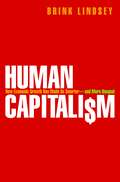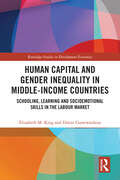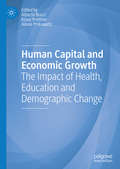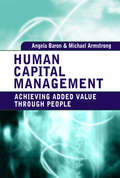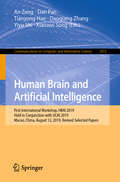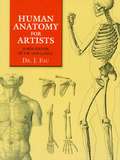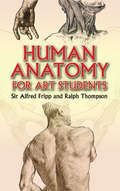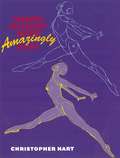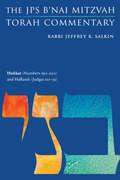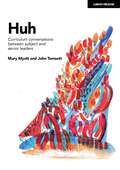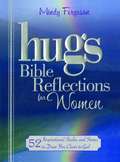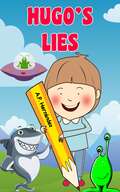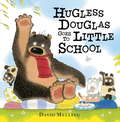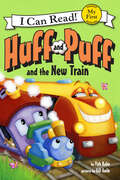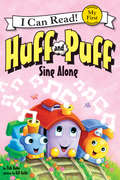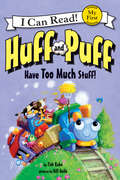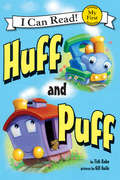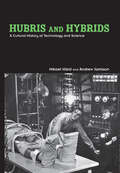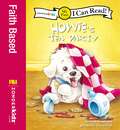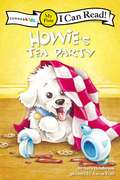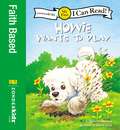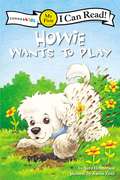- Table View
- List View
Human Capitalism: How Economic Growth Has Made Us Smarter--and More Unequal
by Brink LindseyWhy the rich are getting smarter while the poor are being left behindWhat explains the growing class divide between the well educated and everybody else? Noted author Brink Lindsey, a senior scholar at the Kauffman Foundation, argues that it's because economic expansion is creating an increasingly complex world in which only a minority with the right knowledge and skills—the right "human capital"—reap the majority of the economic rewards. The complexity of today's economy is not only making these lucky elites richer—it is also making them smarter. As the economy makes ever-greater demands on their minds, the successful are making ever-greater investments in education and other ways of increasing their human capital, expanding their cognitive skills and leading them to still higher levels of success. But unfortunately, even as the rich are securely riding this virtuous cycle, the poor are trapped in a vicious one, as a lack of human capital leads to family breakdown, unemployment, dysfunction, and further erosion of knowledge and skills. In this brief, clear, and forthright eBook original, Lindsey shows how economic growth is creating unprecedented levels of human capital—and suggests how the huge benefits of this development can be spread beyond those who are already enjoying its rewards.
Human Capital and Gender Inequality in Middle-Income Countries: Schooling, Learning and Socioemotional Skills in the Labour Market (Routledge Studies in Development Economics)
by Elizabeth M. King Dileni GunewardenaThe role of cognitive and socioemotional skills alongside education in determining people’s success in the labour market has been the topic of a growing body of research—but previous studies have mostly missed middle-income countries and the developing world because measures of those skills and data on employment and earnings on large enough samples of adults have typically not been available. Using comparable survey data on these schooling, skills, and labour market outcomes from 13 developing and emerging economies worldwide, this book revisits human capital and gender inequality models. It presents new estimates of the returns to different levels of schooling as well as the cognitive and socioemotional skills for women and men. It examines whether those returns are due to levels of human capital or to structural bias in labour markets, and how these two factors work across the earnings spectrum. The book examines the existence of “glass ceilings” and “sticky floors” for women using this expanded measure of human capital. Further, by analyzing a group of countries of wide-ranging levels of economic development and sociopolitical contexts, the book reveals patterns and insights into how context mediates the relationship between skills and gender gaps in labour market outcomes. This book will be of interest to scholars of human capital, gender inequality in the labour market and development economics, as well as, gender and development policy makers.
Human Capital and Economic Growth: The Impact of Health, Education and Demographic Change
by Alberto Bucci Klaus Prettner Alexia PrskawetzThis edited collection explores the links between human capital (both in the form of health and in the form of education), demographic change, and economic growth. Using empirical as well as theoretical perspectives, the authors investigate several important issues in the context of human capital, namely population ageing, inequality, public policy, and long-term economic development. Ultimately, they demonstrate that the accumulation of human capital is of crucial importance to long-run economic growth.
Human Capital Management: Achieving Added Value Through People
by Michael Armstrong Angela BaronHuman Capital Management (HCM) has recently been described as a high-level strategic issue that seeks to analyze, measure and evaluate how people policies and practices create value. Put simply, HCM is about creating and demonstrating the value that great people and great people management add to an organization.This unique book describes how HCM provides a bridge between human resource management and business strategy. It also demonstrates how organizations can use the concepts of human resource management and the processes involved to enhance the value they obtain from people while continuing to meet their aspirations and needs.Baron and Armstrong explain how to achieve these objectives using various approaches including describing the concept of HCM and how the process works, discussing its application in numerous areas within an organization and examining the role of HR in HCM and the future of the concept.It also contains a toolkit which organizations can use to develop their own HCM policies and practices.
Human Brain and Artificial Intelligence: First International Workshop, HBAI 2019, Held in Conjunction with IJCAI 2019, Macao, China, August 12, 2019, Revised Selected Papers (Communications in Computer and Information Science #1072)
by Daoqiang Zhang Tianyong Hao An Zeng Dan Pan Yiyu Shi Xiaowei SongThis book constitutes the refereed proceedings of the workshop held in conjunction with the 28th International Conference on Artificial Intelligence, IJCAI 2019, held in Macao, China, in August 2019: the First International Workshop on Human Brain and Artificial Intelligence, HBAI 2019. The 24 full papers presented were carefully reviewed and selected from 62 submissions. The papers are organized according to the following topical headings: computational brain science and its applications; brain-inspired artificial intelligence and its applications.
Human Anatomy for Artists: A New Edition of the 1849 Classic with CD-ROM
by J. FauThis magnificent art book re-creates an extremely rare 1849 guide to anatomy, originally compiled for "artists, painters, and sculptors." Unavailable for more than 150 years, this classic work features 30 plates with 105 highly detailed and finely executed black-and-white lithographs. These realistic and meticulously accurate drawings illustrate form as well as function, offering artists a mastery of anatomy through careful, knowledgeable articulation of the muscles and bones beneath the skin. Each image appears with an identifying caption, and this new edition offers the convenience of a CD-ROM that includes every illustration from the book. In addition to its value as a resource for practicing artists, this beautiful browsing book will captivate anyone who has an interest in the human body.
Human Anatomy for Art Students
by Ralph Thompson Sgt. Sir Alfred FrippA staple of art instruction, this book is the most concise and accessible guide to accurately depicting the human body. Its illustrations and cross-sections offer examples of human skeletal and muscular substructures and details of individual body parts, helping students achieve the most precise visual re-creation of human form and motion.Subjects include the skeleton, the coverings and regions of the body, the upper and lower extremities, movements of the joints, the trunk, and the head and neck. Additional topics encompass expression and gesture, differences of size and proportion in the sexes, and growth, development, and measurements. More than 130 detailed figures appear throughout the text, in addition to thirty-one plates.
Human Anatomy Made Amazingly Easy (Made Amazingly Easy Series)
by Christopher HartFrom head to toe, the human form, in all its complexities, is visually simplified to such a degree in this remarkable workbook that even complete beginners will soon be able to draw accurate, well-proportioned faces and figures every time they try. Avoiding complex charts of muscles and bones that are more helpful to doctors than to artists, this book's refreshing approach teaches anatomy from a cartoonist/illustrator's point of view. For example, there are many large and small muscles in the neck, all rendered in great detail in most anatomy books, but here, master teacher Christopher Hart shows only the four that are visible and need to be drawn. His clear instruction helps readers to visualize and portray shifting body weight in a pose without the need of a model, and instead of showing a mass of facial muscles and bones, he translates them into the simple planes an artist needs to draw a range of expressive faces.
Hukkat: The JPS B'nai Mitzvah Torah Commentary (JPS Study Bible)
by Rabbi Jeffrey K. SalkinHukkat (Numbers 19:1-22:1) and Haftarah (Judges 11:1-3): The JPS B’nai Mitzvah Torah Commentary shows teens in their own language how Torah addresses the issues in their world. The conversational tone is inviting and dignified, concise and substantial, direct and informative. Each pamphlet includes a general introduction, two model divrei Torah on the weekly Torah portion, and one model davar Torah on the weekly Haftarah portion. Jewish learning—for young people and adults—will never be the same. The complete set of weekly portions is available in Rabbi Jeffrey K. Salkin’s book The JPS B’nai Mitzvah Torah Commentary (JPS, 2017).
Huh: Curriculum conversations between subject and senior leaders
by John Tomsett Mary MyattSchools need to have purchase on the curriculum: why they teach the subjects beyond preparation for examinations, what they are intending to achieve with the curriculum, how well it is planned and enacted in classrooms and how they know whether it’s doing what it’s supposed to. Fundamental to this understanding are the conversations between subject leaders and their line managers. However, there is sometimes a mismatch between the subject specialisms of senior leaders and those they line manage. If I don’t know the terrain and the importance of a particular subject, how can I talk intelligently with colleagues who are specialists? This book sets out to offer some tentative answers to these questions. Each of the national curriculum subjects is discussed with a subject leader and provides an insight into what they view as the importance of the subject, how they go about ensuring that knowledge, understanding and skills are developed over time, how they talk about the quality of the schemes in their departments and what they would welcome from senior leaders by way of support. We have chosen this way of opening up the potentially difficult terrain of expertise on one side and relative lack of expertise on the other, by providing these case studies. They are suggested as prompts rather than the last word. Informed debate is, after all, the fuel of curriculum development. And why Huh? Well, 'Huh?' may be John's first response when he walks into a Year 8 German class but, in fact, we chose 'Huh' as the title of our book as he is the Egyptian god of endlessness. As Claire Hill so eloquently comments in her chapter, “Curriculum development is an ongoing process; it’s not going to be finished, ever.” And we believe that 'Huh' captures a healthy and expansive way of considering curriculum conversations.
Huh: Curriculum conversations between subject and senior leaders
by John Tomsett Mary MyattSchools need to have purchase on the curriculum: why they teach the subjects beyond preparation for examinations, what they are intending to achieve with the curriculum, how well it is planned and enacted in classrooms and how they know whether it’s doing what it’s supposed to. Fundamental to this understanding are the conversations between subject leaders and their line managers. However, there is sometimes a mismatch between the subject specialisms of senior leaders and those they line manage. If I don’t know the terrain and the importance of a particular subject, how can I talk intelligently with colleagues who are specialists? This book sets out to offer some tentative answers to these questions. Each of the national curriculum subjects is discussed with a subject leader and provides an insight into what they view as the importance of the subject, how they go about ensuring that knowledge, understanding and skills are developed over time, how they talk about the quality of the schemes in their departments and what they would welcome from senior leaders by way of support. We have chosen this way of opening up the potentially difficult terrain of expertise on one side and relative lack of expertise on the other, by providing these case studies. They are suggested as prompts rather than the last word. Informed debate is, after all, the fuel of curriculum development. And why Huh? Well, 'Huh?' may be John's first response when he walks into a Year 8 German class but, in fact, we chose 'Huh' as the title of our book as he is the Egyptian god of endlessness. As Claire Hill so eloquently comments in her chapter, “Curriculum development is an ongoing process; it’s not going to be finished, ever.” And we believe that 'Huh' captures a healthy and expansive way of considering curriculum conversations.
Hugs Bible Reflections for Women
by Mindy FergusonThe latest in the bestselling Hugs series features inspiring Bible verses paired with heartwarming stories written by ordinary women who have stepped out in faith and experienced God's faithfulness to them.Hugs Bible Reflections for Women is a moving collection of stories told by women who are not afraid to bare their souls and share their hard-earned life wisdom. Full of inspirational quotes, scripture, insightful tips, and biblical principles, this heartwarming book will strengthen the faith of those special women in your life.Building on its own bestselling success, the Hugs series focuses on Christian women's growing interest in finding useful tools that will encourage them to refresh their outlook on life. Readers are sure to relate to these personal stories and the thought-provoking reflection questions that follow each story. So whether you are searching for the "just right" present for a friend, or want a nurturing read that will help you through those rough patches in life, Hugs Bible Reflections for Women is sure to deepen any woman's relationship with God.
Hugo’s Lies: Children's book for 6 to 7 year olds
by A. P. HernándezHugo is seven years old and a liar. He loves to stretch the truth! Whenever he can, he tells a fib. It's super fun! Or, at least, so he thinks ...
Hugless Douglas Goes to Little School (Hugless Douglas #6)
by David MellingA charmingly funny Hugless Douglas story. Perfect for reassuring little ones going to school or nursery for the first time.It's a big day for Hugless Douglas. He's starting Little School. Douglas is a bit nervous at first... but soon he's having lots of fun playing with his new friends and joining in with all the fun activities!"A new Hugless Douglas book is always a cause for celebration." Daily Mail"Hugless Douglas fits right in with the well-loved classics." GuardianThe much-loved Hugless Douglas books have sold over 1.6 million copies. Combining brilliantly imaginative illustrations with an endearing sense of what it's like to be a small child learning about the world.
Hugging The Middle: How Teachers Teach in an Era of Testing and Accountability
by Larry CubanFOR DECADES, educational researchers and policymakers have looked upon medical education, university research, and clinical practice as the gold standard for teacher educators, scholars, and teachers to copy.
Huff and Puff and the New Train (My First I Can Read)
by Tish RabeHuff and Puff are a team who stay on track: Huff pulls the train. Puff pushes the train. But when a new speedy train challenges the pair to a race, the caboose and engine must find out if slow and steady can win the race. Ready, set, go!With colorful illustrations from Gill Guile and fun, simple rhymes and verse from Tish Rabe, Huff and Puff will help beginning readers and train lovers strengthen their reading skills. This is a My First I Can Read book, which means it's perfect for shared reading with a child.Supports the Common Core State Standards.
Huff and Puff Sing Along (My First I Can Read)
by Tish RabeWhen a third train chugs onto the scene, Huff and Puff learn how to share their friends. Join the fun with these two sweet trains in an easy-to-read story that's perfect for beginning readers. Each book in the Huff and Puff series has simple verse and rhyme, designed by experts to help children learn to read in the easiest and most enjoyable way.Author Tish Rabe has written over 120 children's books, including titles for Sesame Street, Blue's Clues, Clifford the Big Red Dog, and Curious George. In Huff and Puff, she and artist Gill Guile have created endearing train characters children will love.
Huff and Puff Have Too Much Stuff! (My First I Can Read)
by Tish RabeHuff pulls the train. Puff pushes the train. Together they can haul a lot. Big stuff, small stuff, they’ve got it all! But what happens when the best friends realize that they’re stuck with too much stuff? Farmer Fluff has a brilliant idea! With colorful illustrations from Gill Guile and fun, simple rhymes and verse from Tish Rabe, Huff and Puff help beginning readers and train lovers build their reading skills. This is a My First I Can Read book, which means it’s perfect for shared reading with a child.
Huff and Puff (My First I Can Read)
by Tish RabeHuff pulls the train. Puff pushes the train. Day in and day out, the train clicks and clacks down the tracks. But one day, Huff and Puff decide to trade places. Will the train come to a halt?With colorful illustrations from Gill Guile and fun, simple rhymes and verse from Tish Rabe, Huff and Puff will help beginning readers and train lovers strengthen their reading skills. This is a My First I Can Read book, which means it's perfect for shared reading with a child.Supports the Common Core State Standards.
Hubris and Hybrids: A Cultural History of Technology and Science
by Andrew Jamison Mikael HårdHuman societies have not always taken on new technology in appropriate ways. Innovations are double-edged swords that transform relationships among people, as well as between human societies and the natural world. Only through successful cultural appropriation can we manage to control the hubris that is fundamental to the innovative, enterprising human spirit; and only by becoming hybrids, combining the human and the technological, will we be able to make effective use of our scientific and technological achievements.This broad cultural history of technology and science provides a range of stories and reflections about the past, discussing areas such as film, industrial design, and alternative environmental technologies, and including not only European and North American, but also Asian examples, to help resolve the contradictions of contemporary high-tech civilization.
Hoy por ti, ¡tomorrow también! (Serie El Club de las Zapatillas Rojas #13)
by Ana Punset¡No te pierdas esta nueva aventura de las chicas de #ElClubDeLasZapatillasRojas! La escuela ha organizado una semana de la solidaridad para ayudar a los refugiados de Siria, y las chicas del club han decidido montar una macrofiesta para recaudar fondos. Pero organizar un evento como este no es fácil y menos cuando las Pitiminís tienen ¡exactamente la misma idea! ¡Aj! Encima, las notas de Lucía han bajado un poco... ¿Y si la castigan sin ir? ¡Help!
Howie's Tea Party: La Merienda De Fido (I Can Read! #My First Shared Reading)
by Sara HendersonEmma pretends Howie is Mrs. Brown, a guest at her tea party. But she soon learns that puppies pay no attention to manners. Beginning readers will learn that God has given everyone their own gift. Howie has his too—being a puppy. Whimsical illustrations complement this wonderfully written story of make-believe.
Howie's Tea Party / La merienda de Fido: La Merienda De Fido (I Can Read! #My First Shared Reading)
by Sara HendersonEmma pretends Howie is Mrs. Brown, a guest at her tea party. But she soon learns that puppies pay no attention to manners. Beginning readers will learn that God has given everyone their own gift. Howie has his too—being a puppy. Whimsical illustrations complement this wonderfully written story of make-believe. Emma pretende que Chispa es la Sra. Brown, una invitada a su merienda. Pero ella pronto aprende que los cachorros no le prestan atención a los buenos modales. Los lectores principiantes aprenderán que Dios le ha dado a cada persona su propio don. Chispa tiene el suyo también: ser un cachorro. Las ilustraciones caprichosas complementan este relato imaginario maravillosamente escrito.
Howie Wants to Play: My First (I Can Read! #My First Guided Reading)
by Sara HendersonIn Howie Wants to Play beginning readers learn that God loves them no matter what. It’s a lesson playful Howie learns after he makes some big messes. The fun illustrations match the tone of the story. My First-level readers will find this book to be as irresistible as Howie himself.
Howie Wants to Play / Fido quiere jugar (I Can Read! #My First Shared Reading)
by Sara HendersonIn Howie Wants to Play beginning readers learn that God loves them no matter what. It’s a lesson playful Howie learns after he makes some big messes. The fun illustrations match the tone of the story. My First-level readers will find this book to be as irresistible as Howie himself. En Chispa quiere jugar los lectores principiantes aprenden que Dios los ama pase lo que pase. Esta es una lección que Chispa aprende después que hace sus buenas trastadas. Las divertidas ilustraciones se corresponden con el tono del relato. Los lectores de nivel 1 hallarán a este libro tan irresistible como el mismo Chispa.
